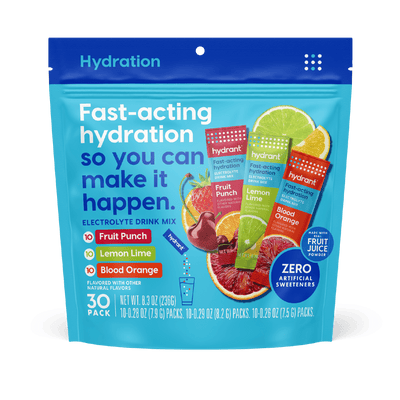There’s no use sugar-coating it —for better or for worse, we all love sugar in our food and drink. Did you know that Americans eat more sugar per person than anywhere else in the world?! [1]
But how much sugar is too much? Does sugar really lead to weight gain, or can we just blame fatty food? What sugars are good or bad for you?
Luckily there’s an ever-growing amount of research to help us understand the role of dietary sugars in our immediate and long-term health. We’ve sorted through the science to find out what’s what. At Hydrant, we believe what you put in your body matters. We’re here to help you navigate it all, so you can stay healthy and hydrated.
Dietary Sugars: Which sugars do we eat?
In our diets, we consume both naturally-occurring sugars and added sugars. Naturally-occuring sugars are those found in food before it’s processed. For example, the fructose in fruit is natural. Added sugars are those that manufacturers add to food, often for taste. A spoon of sugar added to your coffee and chemically-manufactured sugars added to sweet breakfast cereals both count as added sugars [2].
There are also different types of sugar molecules. Though they all taste sweet, each of these has a different effect on your blood sugar and metabolism [3].

Glucose: Probably the sugar you think of first, glucose is used to make corn syrup, which is very common in the American diet. Our bodies also make glucose by breaking down dietary carbohydrates and using them as fuel [4].
Fructose: This is one of our favorites. Fructose tastes really, really sweet, and so is frequently used as a sweetener. It’s naturally found in fruits and vegetables, but it’s so tasty that now we add it to all sorts of stuff, often in the form of High Fructose Corn Syrup (HFCS) [4,5]. About 7% of all packaged foods and beverages have added sugar in the form of fruit juice concentrate. We think it’s ‘healthy sugar’ because it’s from fruit, but adding fructose to our bodies in any form is the same as if HFCS had been used instead [5].
Sucrose: This is the type of sugar you might use on your cereal or when you’re baking; sucrose is plain old table sugar [6]. The sucrose molecule is repeating units of one fructose and one glucose stuck together [4].
Lactose: It might surprise you to hear that lactose is a sugar! But it is indeed–lactose sugar molecules are made of glucose and galactose bonded together, and is naturally found in milk [4].
Dietary Sugars: Health Risks
There are many health problems associated with above-average sugar consumption. We’ve listed some major categories here.
Sugar and Energy
As we’ve seen, your body breaks carbohydrates down into glucose molecules, making the glucose available for energy production. When you eat a whole bunch of sugary snacks at once you hit your body with a load of easy-access energy. So instead of being broken down gradually (you might have heard these called ‘slow-release carbs’) you get all the energy at once. This is why you get a sugar high!

This plays into our daily lives. What do you reach for to start your day? Or reach for as a snack when your energy has started to drop mid-afternoon? For many of us, it’s a sugary cereal–we crave that glucose-hit, for taste as much as for instant energy. However, what effect is this having on our bodies later in the day? Once we’ve had that quick burst of energy, we are left feeling slow and sluggish, because we haven’t provided our body with enough larger carbohydrate molecules to break down into glucose for later in the day.
You should be getting your energy from slow release carbs, not sugars, so that you body can break them down more gradually and keep you energized. The guidelines suggest we should have no more than 10% of our calorie intake through sugars. Most Americans, however, are currently getting more like 13% of daily calories from sugar [4,7].
Sugar and Weight
More than two in every three adults is overweight or obese [8]. Sugar is largely to blame. Carbohydrates, and therefore sugar, are our primary sources of energy. If you consume more energy than you use each day, your body piles it on as extra weight.
 So where are we getting all this extra sugar from? Sugary drinks are a prime culprit. Drinks that have added sugar—ahem, soda and sports drinks—have been frequently scientifically associated with increased weight gain [9,10]. Remember also that fruit juices have large amounts of fructose in them. It doesn’t make a difference whether it’s added to the drink, or occurs naturally, sugar still has a negative impact on your body! [5]
So where are we getting all this extra sugar from? Sugary drinks are a prime culprit. Drinks that have added sugar—ahem, soda and sports drinks—have been frequently scientifically associated with increased weight gain [9,10]. Remember also that fruit juices have large amounts of fructose in them. It doesn’t make a difference whether it’s added to the drink, or occurs naturally, sugar still has a negative impact on your body! [5]
There is some evidence to show that fructose seems to increase your appetite for more food than you need via its interference with lectin. So eating fructose, which is associated with weight gain, causes you to want to eat more fatty and sugary foods, which makes you gain even more weight! If you are feeling sluggish because of a sugary diet, then you’re more likely to feel like plopping on the couch, rather than being active, which leads to further weight gain [10].
Sugar and Diabetes
Fructose and glucose are the sugars associated most strongly with development of Type 2 Diabetes [3]. Diabetes is a serious health condition, the basis of which is a high blood glucose level. High levels mean there’s lots of that easy access energy in your blood, but your cells can’t access it, meaning you might feel super tired.
When you have a meal, the glucose that is released into your blood causes your pancreas to release a hormone called insulin that helps your cells to take up and use or store the glucose. If you’re constantly eating a lot of sugar, the cells in your pancreas can get overwhelmed because of the high need for them, and stop being able to produce insulin. The other cells in your body stop recognizing insulin because they are bombarded with so much of it due to the high glucose levels. This can mean you stop making insulin and/or your cells lose the ability to take up insulin.
As you might know, there are several types of diabetes, all with a different mechanism of disease. The long and the short of it is that your blood glucose levels become very difficult to control. Type 2 diabetes is a current epidemic in the Western World, because of our intensely high sugar consumption [11].
The list of problems goes way beyond what we can mention here and includes fatty liver disease and metabolic syndrome [5] as well as cognitive decline, several types of cancer, stress, cavities, and aging [1].
How can we cut down on dietary sugars?
In order to cut down on sugar, we first need to work out how much we’re consuming.
This diagram from Dietary Guidelines 2015-2020 shows really clearly how, on average, we are eating. Orange bars extending towards the left indicate a deficiency in diet and blue bars indicate an excess in diet. For example, we’re eating too much sugar, but not enough grain. To be healthier we should be trying to get more calories from grain, and less from sugars.

There are a bunch of artificial sweeteners that are added to foods instead of sugar. They are much more intensely sweet than real sugars, so are only added in very small amounts to everything from yogurt to chewing gum [12]. However, these aren’t a perfect solution—artificial sweeteners come with problems of their own, and foods containing them may still have a high carbohydrate content. But eating foods with some artificial sweeteners may be a step in the right direction if you have a very high sugar intake that you’re trying to cut.
You could try a diet tracking app to see how much sugar you are eating each day, and identify the different foods it’s coming from to help you make the change.
You can still eat sugar!
Most of us have good reason to cut down on sugar, whether it’s to get more energy through the day, lose weight, care for our teeth, or decrease diabetes risk. We also need to be aware that sugar is sugar, whatever form it is in—don’t be fooled by ‘caloric sweeteners!’
If you want to cut sugar out of your diet, try doing so gradually by making small adjustments each day or each week. And remember to reach for something with less sugar and more slow-release carb content to keep you going for longer.
But need that good-sugar boost right now? Skip the sports drink and opt for Hydrant instead. It’s the good kind of sugar.
Writer: Ailsa McKinlay
Editor: Elizabeth Trelstad, www.hellobeaker.com

























